NEA on the Road: National Council on the Arts in Ohio
On June 27–28, 2024, NEA Chair Maria Rosario Jackson, PhD and members of the National Council on the Arts (NCA) visited Ohio to experience its diverse communities, with a focus on highlighting the importance of the arts in rural places. Throughout the visit, Chair Jackson and council met with local leaders who are working to strengthen communities and improve quality of life for all by honoring local history and culture, bolstering economies and providing job opportunities, and creating belonging and connection.
Athens—Passion Works Studio and Mount Zion Black History Center
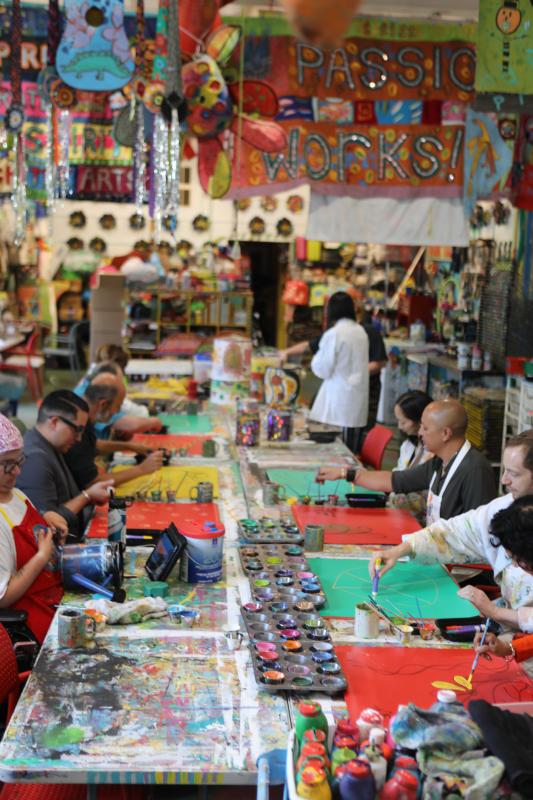
Passion Works Studio artists, NEA staff, and National Council on the Arts members work on art projects using upcycled materials during the NEA’s visit. Photo by Scotty Hall, @stealyoursoulphotography
Passion Works Studio in Athens, Ohio, creates opportunities for people with and without developmental differences to explore their creativity and socially connect through the process of making collaborative art. Founder and Executive Director Patty Mitchell led Chair Jackson and NCA members through their space, which houses a studio and shop that sells the artwork created there using upcycled materials. Mitchell shared Passion Works’ impact in a variety of ways—social, economic, and environmental—including helping to cultivate artists’ confidence and sense of identity as well as their sense of community. Surrounded by artists’ creations and art supplies, at a large table in the center of the studio, NCA members and staff joined Passion Works artists to learn more about projects they work on, including the creation of their signature product, the Passion Flower, made of painted upcycled aluminum newspaper printing plates, that are then cut out, sculpted and constructed.

A Passion Works Studio artist with NEA staff and National Council on the Arts members. Photo by Scotty Hall, @stealyoursoulphotography
Passion Works’ deep involvement in the community was evident, as some artists worked on materials for the upcoming Nelsonville Music Festival and large-scale puppets decorated the walls from their local Honey for the Heart Parade. A synergy among local organizations to uplift their community through arts and culture was noticeable, and this sense connection carried into the next visit with the Mount Zion Black Cultural Center.
The center’s communications director Dr. Trevellya “Tee” Ford-Ahmed introduced the NEA visitors to local sites in the Southeastern Ohio River Valley significant to the Underground Railroad, a network that helped to provide shelter and aid to enslaved people seeking their freedom. In a podcast with the NEA, Ford-Ahmed explained: “[F]olks generally don't associate Blacks with Appalachia, but we have a deep history…. This was a stop on the Underground Railroad—many were traveling through here on their way to freedom and ended up stopping. There was one way in, one way out. They were under the shadow and shade of trees. There was a coal mine industry, as well as a brick developing industry here. That's probably why this town settled a certain amount of Blacks escaping slavery, and those who were freeborn, to settle here and start their life. That's how this particular community developed.”
Starting at the former site of Hotel Berry, opened in the 1890s by Black entrepreneurs and community leaders Edward and Martha Jane Berry, Brian Koscho showed the group how to use his Invisible Ground Augmented Reality App to see the hotel as it once stood. The Berrys also donated the land for the Mount Zion Baptist Church, built in 1905, that is the focus of the center’s work.
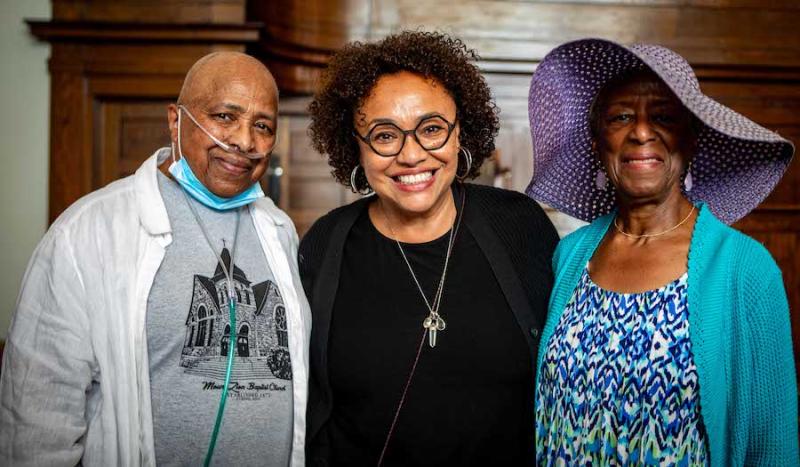
President of the Mt. Zion Black Cultural Center Ada-Woodson Adams, NEA Chair Maria Rosario Jackson, and Communications & Media Director of the Mt. Zion Black Cultural Center Trevellya "Tee" Ford-Ahmed. Photo by Scotty Hall, @stealyoursoulphotography
In 2019, the center (formally called the Mount Zion Baptist Church Preservation Society) was accepted as a Citizens’ Institute on Rural Design (CIRD) community participant. An initiative of the NEA in partnership with the Housing Assistance Council, CIRD helps small, rural communities tackle their unique preservation and crehabilitation issues for the social and economic benefit of the community. Through CIRD, Mount Zion worked to refine their vision for the restoration of the 120-year-old building into a dynamic community center. Architect and designer Omar Hakeem of To Be Done Studio worked as the CIRD design lead for the project, helping to plot out how to take the church building and, as he told the NEA in 2021, “reimagine it as a hub for Black history and culture. We spent a lot of time talking about what does that mean for people? What does that look like?”
This work is moving forward with the help of a more than $7 million grant as part of the Appalachian Community Grant Program’s Appalachian Downtowns and Destinations Initiative, announced earlier this year. The intricate knowledge of historical Black life in Athens shared by Ford-Ahmed and the center’s president, Ada-Woodson Adams, gave meaningful voice to the city’s past and how they are carrying this legacy forward in their work today. They recently added a temporary mural to the building, created by artist Keith Wilde and unveiled on Juneteenth. The mural takes the place of the original stained glass, removed for restoration and to ensure its safety during construction. The mural depicts the origins of the church and was created with the help of more than 80 people, many of whom worked in Passion Works studio on the project.
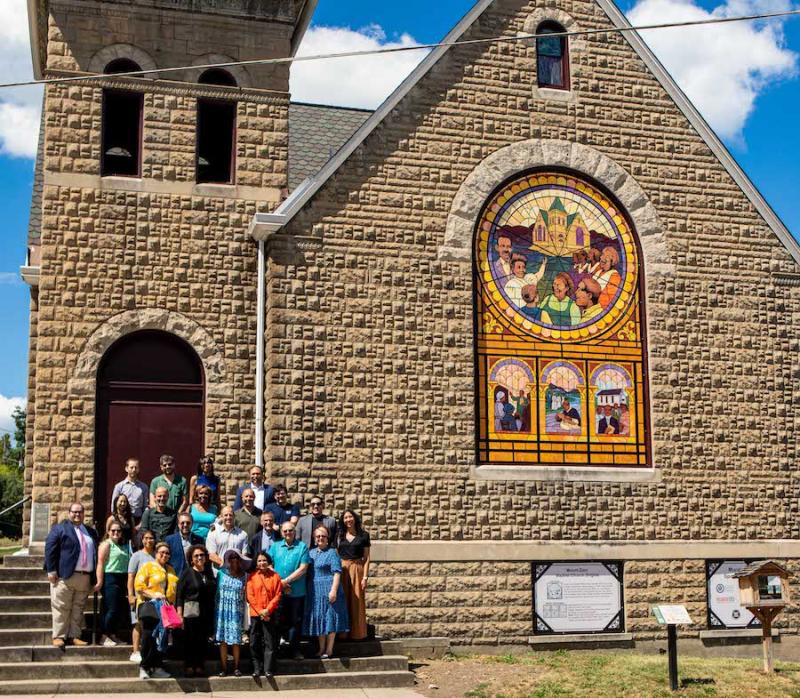
Mount Zion Black Cultural Center leadership with NEA staff and National Council on the Arts members outside the Mount Zion building and their newly unveiled mural. Photo by Scotty Hall, @stealyoursoulphotography
Reflecting on her visits to Passion Works Studio and Black Cultural Center at a Town Hall meeting that evening, Chair Jackson noted: “The organizations and work that we witnessed today are stellar examples of what so many communities around the country need—this deep understanding that the arts lift up our humanity, allow us to deliver the gifts that we have to the world, and allow us to care for each other.”
Nelsonville—Town Hall at Stuart’s Opera House
The Town Hall conversation took place at Stuart’s Opera House in Nelsonville and focused on the arts and its impact on our communities. Ohio Arts Council Executive Director Donna S. Collins moderated the conversation, which in addition to Chair Jackson included Ohio State Representative Jay Edwards; Executive Director of Stuart’s Opera House Melissa Wales; and Brandon Thompson, an artist and entrepreneur from Athens.

(l-r) State Representative Jay Edwards, NEA Chair Maria Rosario Jackson, Ohio Arts Council Executive Director Donna S. Collins, Executive Director of Stuart's Opera House Melissa Wales, and artist and entrepreneur Brandon Thompson. Photo by Scotty Hall, @stealyoursoulphotography
In a conversation that touched on cross-sector collaborations, how the arts can help to build healthy communities, and the importance of arts education, the panelists also demonstrated, in Chair Jackson’s words, that “there is an identity, a sensibility, an aesthetic, that is Appalachian Ohio and it deserves to be expressed and appreciated.” “That’s what I love about living in this part of the state,” said Wales. “The resiliency, the culture, the creativity, and the community work that is so long, deep, and rich in this community.” Watch the Town Hall.
Columbus—National Council on the Arts Meeting at Lincoln Theatre
The following day, at the historic Lincoln Theatre in Columbus, the NEA held its 213th meeting of the National Council on the Arts. With a continued focus on the arts in rural areas, Ohio Arts Council’s (OAC) Donna Collins opened the meeting, asserting her organizations’ commitment to serving these communities: “At the OAC, we know and we value Ohio’s rural communities. Through our work to Fund Every County, the Ohio Arts Council actively makes grants in all 88 counties of the state, including our 72 counties classified as rural or partially rural.”
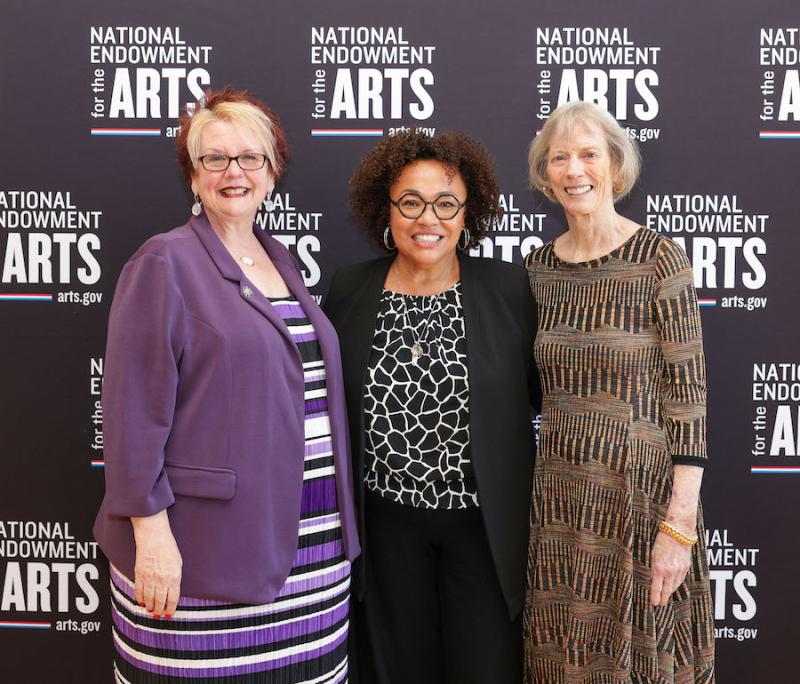
(left to right) Ohio Arts Council Executive Director Donna S. Collins, NEA Chair Jackson, and Ohio Arts Council Board Chair Ginger Warner. Photo by Terry Gilliam
The Columbus Jazz Youth Orchestra, which is housed at the Lincoln Theatre, provided two educational performances during the meeting. Jordan Steinbrook performed his original composition, “A Walk in the Park,” on the piano and another pianist, Benjamin Adams, accompanied National Council on the Arts member and acclaimed musician Kinan Azmeh in performing Azmeh’s composition “Two Syrian Imaginary Dances, first movement.”

Benjamin Adams of the Columbus Jazz Youth Orchestra and National Council on the Arts member Kinan Azmeh. Photo by Terry Gilliam
NEA Director of Design and Creative Placemaking Ben Stone organized two conversations with arts and design leaders exploring the contributions of arts and culture in rural areas through creating connections and strengthening the health and well-being of individuals and communities, and more.
Omar Hakeem and Tee Ford-Ahmed discussed their collaboration on the Mount Zion Black Cultural Center as part of CIRD. Hakeem said that through CIRD “we get to be friends and colleagues and partners and so we have time and space to listen and understand better the vision that people are seeking and we also have space to get down into the details.”
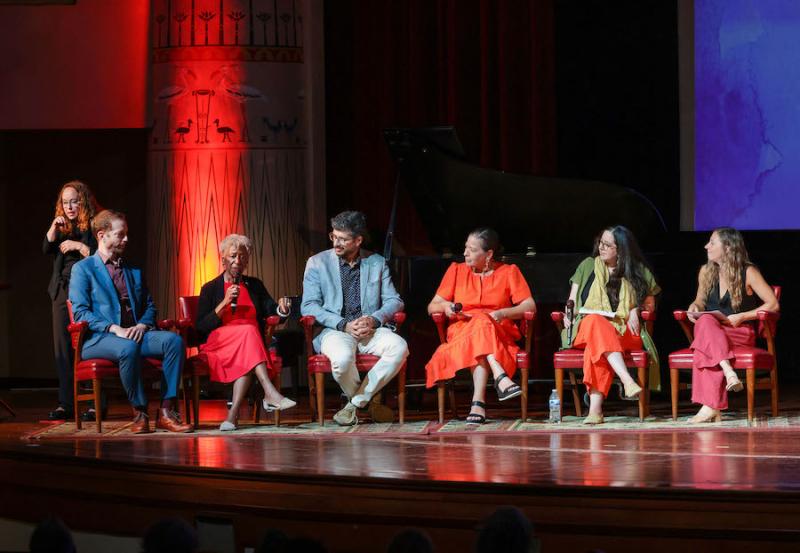
(left to right) NEA Director of Design and Creative Placemaking Ben Stone, Communications & Media Director of the Mount Zion Black Cultural Center Trevellya Ford-Ahmed, Founder and Principal of To Be Done Studio Omar Hakeem, Executive Director of Mni Sota Arts Anne O’Keefe-Jackson, Department of Public Transformation Activate Rural Program Director Sarina Otaibi, and Department of Public Transformation Creative Executive Officer Ash Hanson. Photo by Terry Gilliam
Department of Public Transformation Creative Executive Officer Ash Hanson led the second conversation, focused on their Activate Rural Learning Lab, a cohort-based peer network, workshop series, and resource hub. The Learning Lab supports community leaders and artists in cultivating welcoming and creative physical places that help create connection in rural communities.
Anne O’Keefe-Jackson (Lower Sioux Indian Community), executive director of Mni Sota Arts in Redwood Falls, Minnesota, spoke about their participation in this cohort as they work to activate a downtown building: “It’s six miles outside of our reservation in Morton and so it was important for us to reclaim that space in Redwood Falls where there was not currently any Native-owned property, to bring a connection to the colonized history, accurate history of Dakota people, and Native artists in general from across the country—to give an opportunity for their voices, their artwork to be seen and to have that in that area and to be a catalyst for community conversations.”

Rural arts development leaders in conversation with National Council on the Arts members. Photo by Terry Gilliam
An ongoing theme throughout the conversation was that projects like these take time—both to build community trust and to work to realize their vision. “Community engagement, talking to people,” is how Hakeem described one of the most important elements in this work. “I think especially in rural places… when things slide back a little bit it's hard to move them forward again. So start arms wide and get as many people into the conversation. And of course, when you get people into the conversation you have to respond to what they're saying and listen. If that means shifting something, shift, but arms wide and just start marching it forward.”
Watch the National Council on the Arts Meeting.

